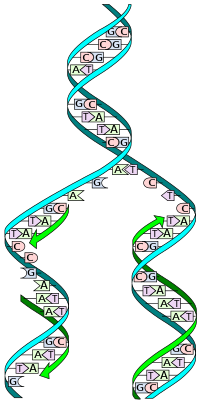
Photo from wikipedia
The use of DNA as a structural material for nanometre-scale construction has grown extensively over the last decades. The development of more advanced DNA-based materials would benefit from a modular… Click to show full abstract
The use of DNA as a structural material for nanometre-scale construction has grown extensively over the last decades. The development of more advanced DNA-based materials would benefit from a modular approach enabling the direct assembly of additional elements onto nanostructures after fabrication. RecA-based nucleoprotein filaments encapsulating short ssDNA have been demonstrated as a tool for highly efficient and fully programmable post-hoc patterning of duplex DNA scaffold. However, the underlying assembly process is not fully understood, in particular when patterning complex DNA topologies. Here, we report the effect of basepair-mismatched regions and single-strand nicks in the double-stranded DNA scaffold on the yield of RecA-based assembly. Significant increases in assembly yield are observed upon the introduction of unpaired basepairs directly adjacent to the assembly region. However, when the unpaired regions were introduced further from the assembly site the assembly yield initially decreased as the length of the unpaired region was increased. These results suggest that an unpaired region acts as a kinetic trap for RecA-based nucleoprotein filaments, impeding the assembly mechanism. Conversely, when the unpaired region is located directly adjacent to the assembly site, it leads to an increase in efficiency of RecA patterning owing to increased breathing of the assembly site.
Journal Title: Scientific Reports
Year Published: 2017
Link to full text (if available)
Share on Social Media: Sign Up to like & get
recommendations!